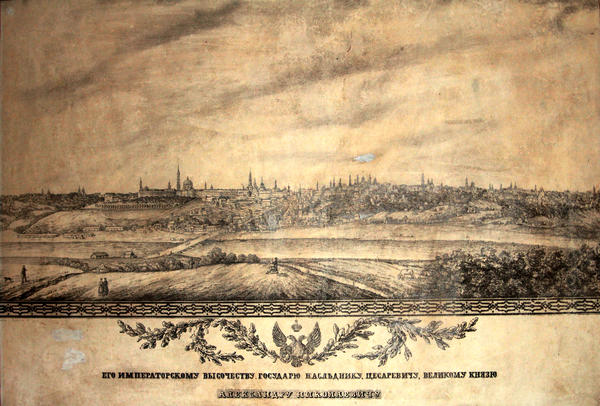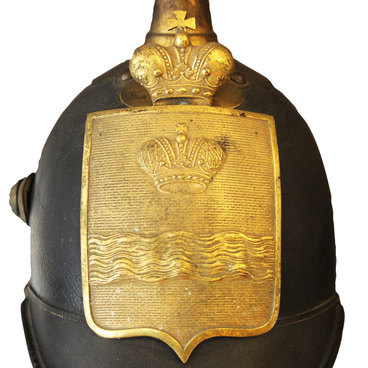Nikolay Sokolov, the author of the drawing View of the Governorate Town of Kaluga, was a well-known artist and architect in the town.
This copy of his work was made in the Lindroth Lithography in accordance with the censorship permission of 10 December 1837. Lithography was a popular printing method in which ink was transferred from a flat plate onto paper under pressure.
The lithograph presented at the exposition is kept in a blue passe-partout with a geometric ornament. The view of the town in the image itself is framed with a separate frame, under which there is a double-headed eagle – the state symbol of the Russian Empire – surrounded by a floral pattern.
The lithograph View of the Governorate Town of Kaluga was presented in 1837 as a gift to Grand Duke Alexander Nikolaevich during his visit to the town. The future Emperor Alexander II visited Kaluga during a long trip across Russia in the company of his mentor Vasily Zhukovsky, a famous poet.
The Tsarevich’s trip through Russia lasted more than six months, from May to December. During this time, Alexander Nikolaevich managed to visit 28 governorates and covered approximately 12 thousand miles (about 13 thousand kilometres).
One of the notes in Grand Duke’s travel diary, which has survived to this day, is dedicated to Kaluga. ‘I left Tula via Ferzikovo, on 11 July 1837, and arrived in Kaluga at 5 pm. After visiting the cathedral, I had lunch with the governor and went to the ball at 9 o’clock… on the 12th of July visited the prison, artillery parks, the Orphanage, and the gymnasium’.
From the town, Alexander Nikolaevich went on a trip to places related to the Patriotic War of 1812, visited Bryansk, Smolensk, Klimov Zavod. And on 20 July he returned to Kaluga again to see the Avchurino estate. General-Adjutant Semyon Yuryevich, the second mentor who accompanied the heir on the trip, recalled:
’… After lunch we went to the estate of Poltoratsky 16 verstas from the town, famous for a long time for using the English method of agriculture. Grand Duke with his retinue rode through the fields to see how they are tilled with this method; examined with attention all agricultural implements, threshing with a machine, fanning out of the grain through the medium of a machine, and He Himself tried to plough with the English plough adapted to our soil’.
This copy of his work was made in the Lindroth Lithography in accordance with the censorship permission of 10 December 1837. Lithography was a popular printing method in which ink was transferred from a flat plate onto paper under pressure.
The lithograph presented at the exposition is kept in a blue passe-partout with a geometric ornament. The view of the town in the image itself is framed with a separate frame, under which there is a double-headed eagle – the state symbol of the Russian Empire – surrounded by a floral pattern.
The lithograph View of the Governorate Town of Kaluga was presented in 1837 as a gift to Grand Duke Alexander Nikolaevich during his visit to the town. The future Emperor Alexander II visited Kaluga during a long trip across Russia in the company of his mentor Vasily Zhukovsky, a famous poet.
The Tsarevich’s trip through Russia lasted more than six months, from May to December. During this time, Alexander Nikolaevich managed to visit 28 governorates and covered approximately 12 thousand miles (about 13 thousand kilometres).
One of the notes in Grand Duke’s travel diary, which has survived to this day, is dedicated to Kaluga. ‘I left Tula via Ferzikovo, on 11 July 1837, and arrived in Kaluga at 5 pm. After visiting the cathedral, I had lunch with the governor and went to the ball at 9 o’clock… on the 12th of July visited the prison, artillery parks, the Orphanage, and the gymnasium’.
From the town, Alexander Nikolaevich went on a trip to places related to the Patriotic War of 1812, visited Bryansk, Smolensk, Klimov Zavod. And on 20 July he returned to Kaluga again to see the Avchurino estate. General-Adjutant Semyon Yuryevich, the second mentor who accompanied the heir on the trip, recalled:
’… After lunch we went to the estate of Poltoratsky 16 verstas from the town, famous for a long time for using the English method of agriculture. Grand Duke with his retinue rode through the fields to see how they are tilled with this method; examined with attention all agricultural implements, threshing with a machine, fanning out of the grain through the medium of a machine, and He Himself tried to plough with the English plough adapted to our soil’.



